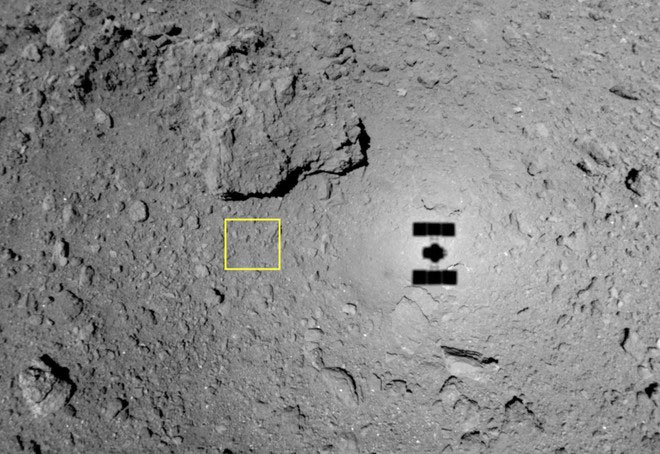Japanese probe brings precious specimens back to Earth
The Japan Aerospace Exploration Agency (JAXA) said the Hayabusa 2 probe had left the asteroid Ryugu and was on its way back to Earth .
According to BGR, JAXA announced that the Hayabusa 2 probe was a miracle. Specifically, the scientists used the method of firing a missile at the surface of the asteroid Ryugu and then collecting rock samples.
'We made the ideal encounter in the best condition. Now I am really relieved. I have been waiting for this moment for a long time, ' said Mr. Yu Yuichi Tsuda - Project Manager of Hayabusa 2.

Shadow of the Hayabusa 2 spacecraft printed on the surface of the Ryugu meteorite.(Photo: JAXA).
It is expected that the Hayabusa 2 probe will reach Earth by 2020. Scientists will recover the rock samples to study. These samples could be clues for scientists to understand more about the origin and formation of the Solar System.
If this mission is successful, Hayabusa 2 will be the first spacecraft to collect specimens under the surface of a meteorite, according to expert Takashi Kubota.
The National Aeronautics and Space Administration (NASA) in 2005 recorded a meteorite impact but did not allow spacecraft to collect specimens.
Hayabusa 2 was launched in 2014 and in June 2018 arrived at the asteroid Ryugu. The asteroid has a diameter of about 900 m and is located nearly 300 million km from Earth. It is named after an undersea palace in Japanese legend.
- See the moment when Japan's Hayabusa 2 spacecraft landed on the asteroid Ryugu
- Hayabusa 2 probe is on its way to approaching the JU3 Ryugu meteorite
- Testing the technology of the lunar exploration ship back to Earth
- The Chinese moon probe returned safely
- Specimen worth 800 million USD
- NASA revealed the mission of the next Mars probe
- NASA launched a meteorite research satellite that could destroy the Earth
- New discovery about the formation of Earth's crust
- China announced rare marine specimens at a depth of 500m
- About 50% of natural history specimens may be being mistakenly named
- Consumption of a 230-year-old French plant was destroyed by Australian customs
- The mission to bring 4.5-year asteroid specimens back to Earth
- NASA creates hundred-ton rockets that collect specimens from planets
- The Japanese space exploration ship has made great strides in its mission to find the source of life
 Van Allen's belt and evidence that the Apollo 11 mission to the Moon was myth
Van Allen's belt and evidence that the Apollo 11 mission to the Moon was myth The levels of civilization in the universe (Kardashev scale)
The levels of civilization in the universe (Kardashev scale) Today Mars, the sun and the Earth are aligned
Today Mars, the sun and the Earth are aligned The Amazon owner announced a secret plan to build a space base for thousands of people
The Amazon owner announced a secret plan to build a space base for thousands of people